“Incidentally, disturbance from cosmic background radiation is something we have all experienced. Tune your television to any channel it doesn’t receive, and about 1 percent of the dancing static you see is accounted for by this ancient remnant of the Big Bang. The next time you complain that there is nothing on, remember that you can always watch the birth of the universe.”
— Bill Bryson
Monthly Archives: November 2010
Adventures in Europe, Chapter 14: I see dead people
When Peter the Great first founded St. Petersburg, which it must be stated again he most definitely did not name after himself, so perish the very thought, it was a swamp.
Everyone said he was daft to build a fortress on a swamp, but he built it all the same, just to show them. It sank into the swamp. So he built a second one. That sank into the swamp. So he built a third. That burned down, fell over, then sank into the swamp. But the fourth one stayed up! And from it, he was able to kick some Swedish spleen and establish control over the Baltics.
Well, not quite, but pretty close. I think the first one actually stayed up all on its own.
The fortress was built on an island close in to modern-day St. Petersburg. You can see it from one of the squares downtown:
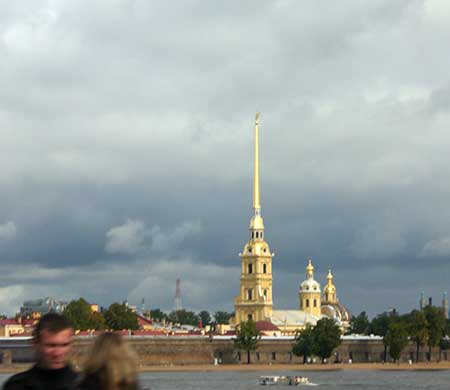
The spire you see here is the roof of the Peter and Paul Cathedral (again, not named after Peter the Great, just to be perfectly clear on that point–it is the merest coincidence that he consistently chose saints who happened by the slightest chance to share a name in common with him when he went around naming things), and yes, that’s real gold. By this point in the trip, I was thinking “My god! Do you know how many iPhones can be made with that much gold?” But then, I’m a pragmatist like that.
The particular square from which this photo was taken is a popular spot for weddings in St. Petersburg. There were no fewer than three wedding parties there at the same time we were:
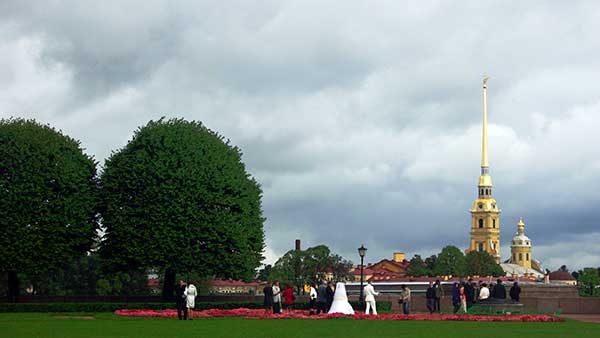
Pros of having a wedding on this spot: It’s picturesque, it’s scenic, the gold spire in the background is so tacky that almost any bridesmaid’s dress looks good in comparison, and there’s at least a 20% chance you won’t be rained on, hailed on, sleeted on, snowed on, or otherwise precipitated upon. Cons: It’s in Russia. You don’t want to be outdoors when the ice weasels come.
This particular square is guarded by brightly colored and elaborately decorated lighthouses, to warn passing ships of the treacherous shoals, swarming with ice weasels, that awaited the incautious sailor.
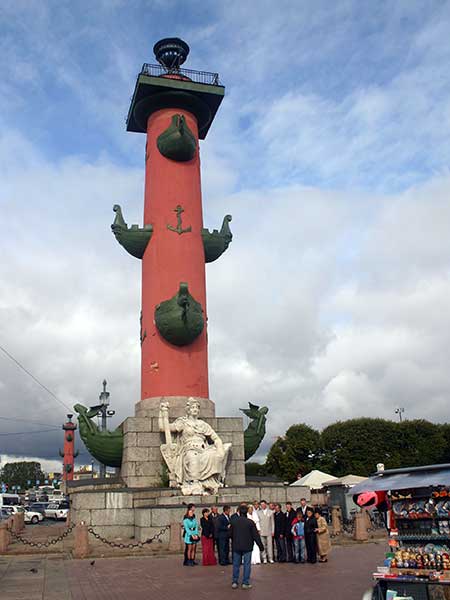
Now, I am not an expert on the design or construction of lighthouses generally. Nor will I claim to any depth of knowledge on the subject of maritime navigation; hell, I can barely drive to the corner convenience store without satellite GPS. So I may be displaying some level of my own naivety when I wonder about the choice of adornment for these lighthouses.
I don’t quite understand what led the architect to decorate these with images of ships projecting entirely through the lighthouse, as I thought that was precisely the eventuality that a lighthouse was intended to prevent.
I don’t know who this rather sad-faced mythic figure is…
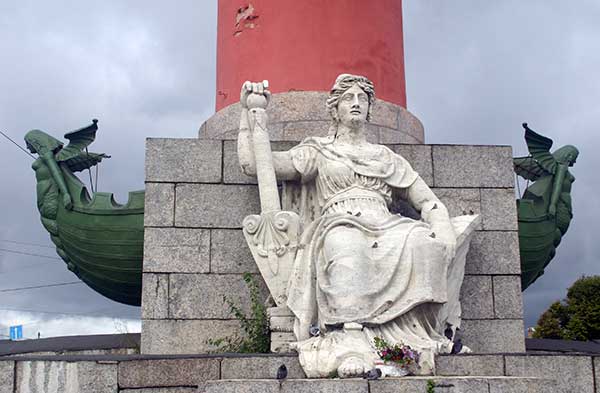
…but the local fauna appeared to believe that she was the Patron Saint of Small Songbirds. Seriously, they were everywhere on her, adorning her liberally with their offerings. And by “their offerings,” I mean “bird shit.”
The boat which has rammed the lighthouse behind her appears not to know whether it’s coming or going.
After we’d properly soaked in the general overview of tacky from afar, we headed to the fortress so that we could get a chance to really appreciate the tacky up close. Peter and Paul Cathedral, the main structure in the center of the fortified island, was at one time a Russian Orthodox church and is currently a tomb for former members of the Russian aristocracy. Peter the Great, Catherine the Great, Catherine the Not So Great As Catherine The Great, Alexander II the Not Very Bright, and Nicholas II the Illiterate (so named because of a stunning inability to read the writing on the wall, so to speak) are all interred here.
The cathedral is about what you’d expect from an ancient Orthodox Russian cathedral: zany in its excess, though with fewer icons of saints than I wold have expected.
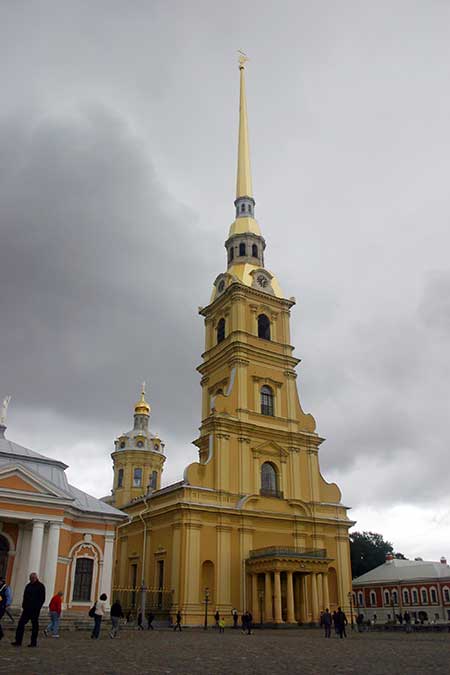
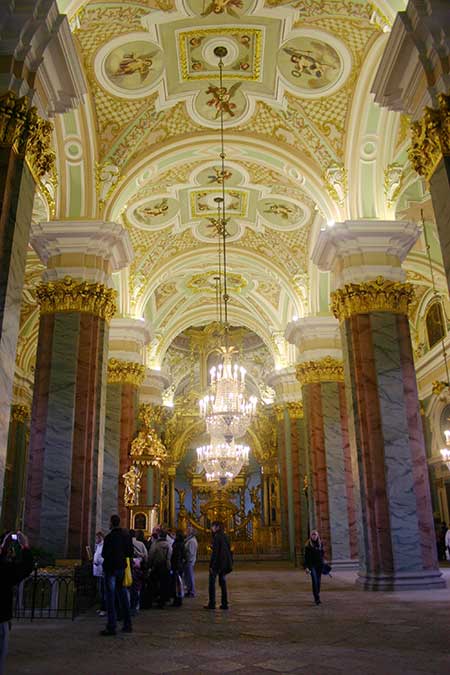
The lack of religious icons of saints is more than compensated for by the plethora of gigantic marble tombs, each of which weighs many tons and contains the mortal remains of someone who believed he could do whatever the hell he wanted to do.
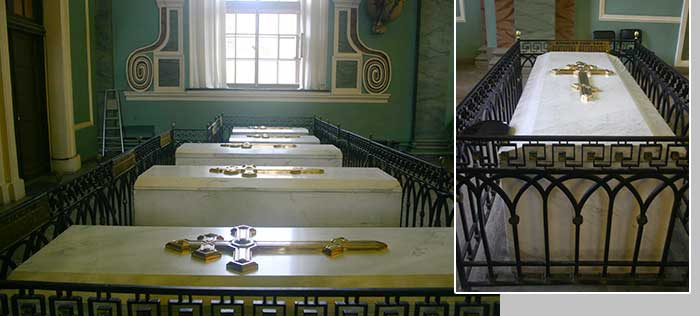
 Russian society has a weird relationship with the Tsars. On the one hand, they venerate their old rulers, and entomb them in enormous cathedrals of gold. On the other hand, they keep them safely trapped beneath massive stone slabs, and surround them all with cold-iron fences–proof against the possibility of some sort of unholy return to life. Apparently, the only thing worse than being ruled by a tsar with an unquenchable thirst for power is being ruled by an undead tsar with an unquenchable thirst for blood.
Russian society has a weird relationship with the Tsars. On the one hand, they venerate their old rulers, and entomb them in enormous cathedrals of gold. On the other hand, they keep them safely trapped beneath massive stone slabs, and surround them all with cold-iron fences–proof against the possibility of some sort of unholy return to life. Apparently, the only thing worse than being ruled by a tsar with an unquenchable thirst for power is being ruled by an undead tsar with an unquenchable thirst for blood.
The Romanians experimented briefly with undead autocratic rulers who had an unquenchable thirst for blood, back when part of Romania was still known by its old name of Transylvania, and the general consensus seemed to be that it didn’t work out so well. During the Convention of 1917, when Russia was still trying to work out how it would be governed in the future, the undead contingent lost out to the Bolsheviks largely because of the Romanian vote. Had they had it all to do over again, the Romanians might concede that perhaps their estimation of what was best for Mother Russia might have been in error, since shambling, blighted, inhuman monsters from the pit of Hell could hardly have done worse than Lenin’s peeps, yo.
But I digress.
Peter the Great’s tomb looks like this:

There’s a bust of him at the end of it, minus his appallingly silly hat, though I can’t help but think he’s probably somewhat the worse looking these days than the bust might indicate. There is a significance to, and a story behind, each one of the coins you see on his casket here. Our petite guide of the nameless name explained it to us, though I was too busy diverting my attention to the cathedral’s defenses against the shambling undead to catch it all.
Peter and Paul Cathedral, named before Mary joined the group, was our last stop in the fair city of St. Petersburg. After that it was back to the floating hotel to bid farewell to Russia. As we left the fort, we said goodbye to this adorable little calico cat, washing herself on the steps to the cathedral in apparent disregard of the slavering undead imprisoned by iron and stone within.

We steamed away from port and headed past Kronstadt, an old sea fortress built by Peter the Great from preventing the Swedes from doing to him what he had done to them and kicking his ass with a huge navy, caliber of hats notwithstanding. It’s an island, frozen for part of the year, around which he built an impressive set of naval fortifications guaranteed to spell certain doom to anyone foolish enough to try to force a passage through it.
Today, it’s still used as a Russian naval base. There was a pair of nuclear attack subs in the port when we steamed by. Unfortunately, it had started raining heavily during our passage, and so I did not get any pictures of the subs that didn’t suck.
The old Imperial-era fortifications themselves are pretty cool, in a James Bond villain kind of way.
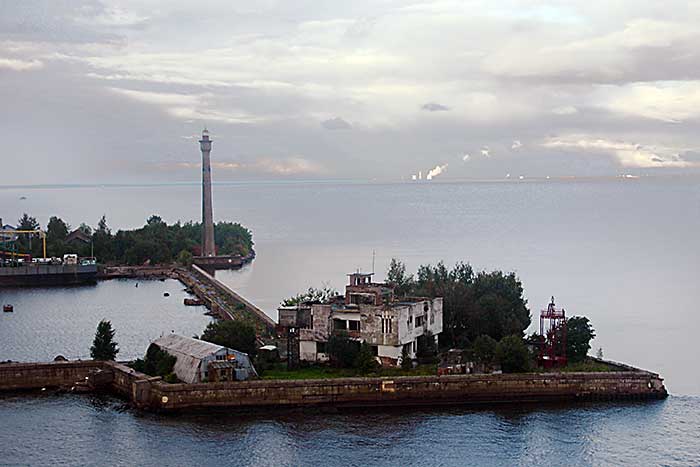
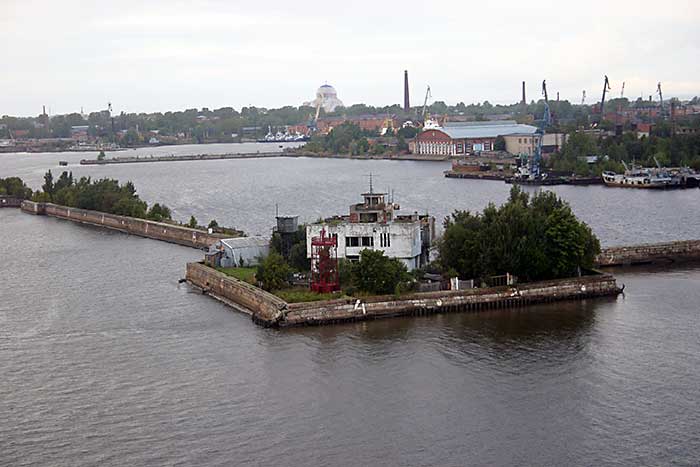
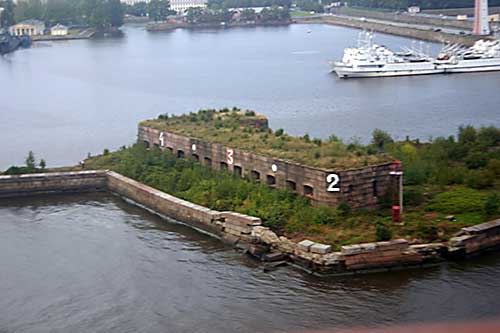
I’m not sure what the numbers mean.
Peter the Great reasoned, correctly to all appearances, that even a huge naval armada would find a series of narrow, walled channels with fortresses and gun emplacements all along them to be a tough nut to crack. Especially when you think of how many cannon it’s possible to stuff into a structure like this:
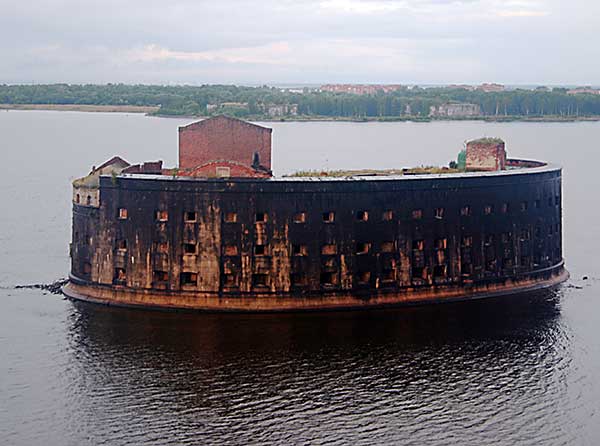
I totally want to live here. With a fluffy cat that I can stroke while hatching plans of unspeakable villainy. Or at least do a photo shoot here.
Adventures in Europe, Chapter 13: Good taste? I’ve heard of that
My visit to the Hermitage museum, formerly the winter residence of Catherine the Great, had left me with the impression that this was a woman of not inconsiderable accomplishment within the general sphere of astonishingly bad taste.
Nearly every part of Catherine’s winter palace is done in the style that modern scholars refer to as “neoclassical tacky,” with finishing details that drew from a wide range of influences such as Gothic Ugly, Baroque Repellent, and Early French Inelegant.
Catherine the First, however, was a woman of no small ambition herself, and was determined to leave an indelible mark on the world of architecture that could never be erased, even with flamethrowers, and would cement her legacy amongst the annals of history. To that end, she commissioned a new summer palace just outside St. Petersburg, which would be nowhere near as small, cramped, or frumpy as the old digs at Peter’s palace.
Her daughter, Empress Elizabeth, was not one to be upstaged by her mother, and upon clawing her way to the throne elected to have the palace entirely rebuilt, a process that required four years, 100 kilograms of gold, and nearly 3,450 metric tons of hideous. So Catherine the Great, when you get right down to it, was merely following in her mother’s and grandmother’s illustrious previous monarch’s footsteps.
We made our way out of the city toward this Altar of Awful, a trek that took us past a monument to the siege of St. Petersburg during WWII, Ford dealership, and a Wrigley’s chewing gum manufacturing plant. We arrived at last at the site of the palace, which is currently located behind a modern containment wall intended to help prevent the tacky from leaking out into the groundwater or contaminating the nearby environment.
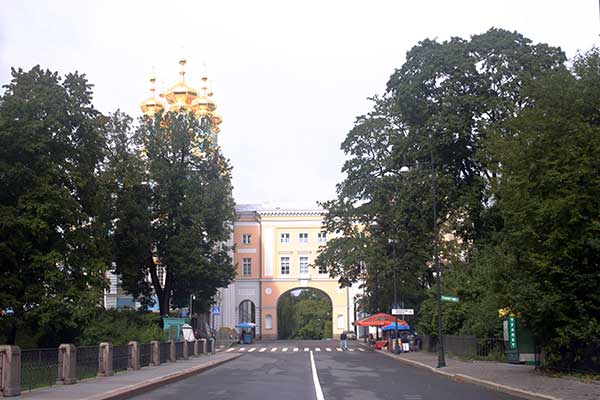
The containment wall isn’t perfect, and a hint of appalling gold-plated onion domes can be seen beyond it.
When we stepped out of our Ford SUV, we were immediately beset by a small gaggle of street performers who asked us where we were from. Upon hearing the answer was “the United States,” they started playing the Battle Hymn of the Republic, and then demanding a tip.
Had we perhaps more time, I could have made this into a learning opportunity for these pioneers of Russian free-market enterprise in the history of American geopolitics by pitching an artfully staged fit at their choice of music; “We are from the South! The South! Do you realize what an insult it is that you present us with this abominable music of the northern aggressors?” But I was in a hurry to have my eyes burned out of my head by pure concentrated awful, so I hurried along after our guide.
The palace is surrounded by a gold-plated iron gate (and God help me, I hope never to have to say those words again) that gives warning to the level of tacky awaiting the luckless bastard who ventures beyond:
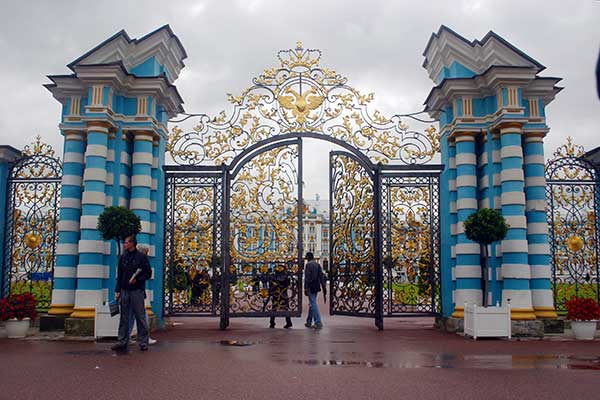
The careful observer will note the ornate double-headed eagle atop the gate. The double-headed eagle was long a symbol of the Russian royalty, a token of their goal, through generations of careful inbreeding, to produce a double-headed heir to the throne.
Which they would have done if it hadn’t been for that meddlesome Lenin and those meddlesome Bolsheviks.
Upon walking through the gate, the casual visitor is immediately struck by the scale of the bigness of the palace, which is quite large in the hugeness of its size. It’s also quite colorful, in the sense that a collision between a truck loaded with raspberry ice cream and a van hauling a shipment of paintballs is “colorful;” there is rather a lot of color everywhere, but one has to believe that there was never any sort of real plan behind it.
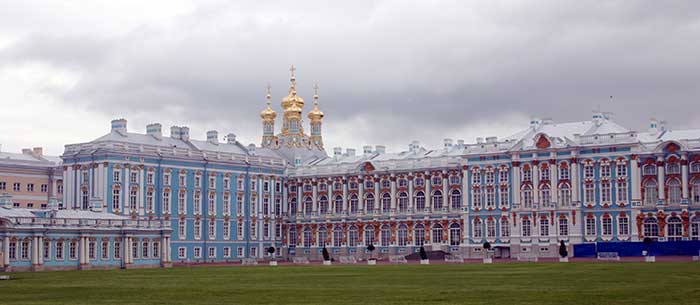
Yes, the roof really is plated in gold. I’ll be saying that a lot.
Viewed from afar, it’s difficult to get a sense of the scale of the place. Yes, it looks big, but everything about it–the windows, the doors, the columns–is oversized, so it’s actually far larger than the picture makes it seem. Here’s a closer shot, with some random folks in it for scale:
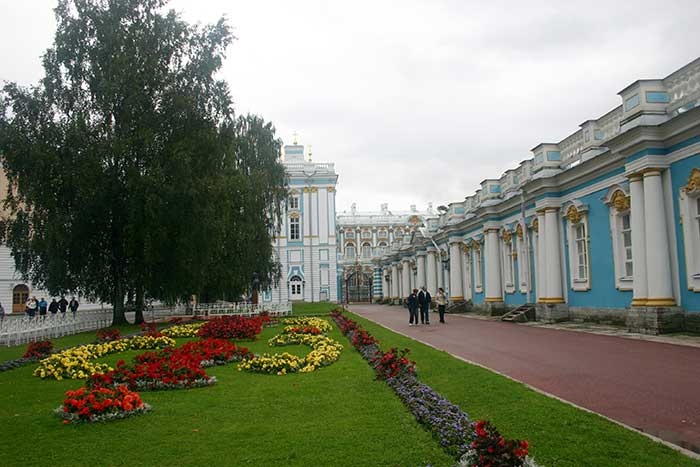
I suspect these folks are locals, just by the casualness with which they walk along; they have, through a process of acclimatization brought about by constant low-grade exposure to the tacky, developed a natural resistance.
All the windows along the front of the building had these unfortunate statues between them.

I imagine that if they could speak, they’d probably be saying something like “Watch, as we hide our faces in shame behind unfortunate hats, so embarrassed we are by our regrettable leglessness!”
After the zany, exuberant excess of the Winter Palace, I was a little surprised by the grand foyer of the Summer Palace, which seemed almost tame in comparison, with the perhaps arguable exception of the paintings on the ceiling.
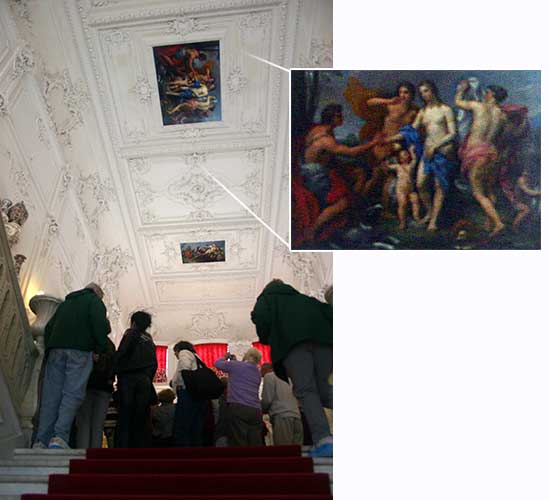
I’m not quite sure what the painting represents, but I think it is intended as a depiction of the popular festival in Russia known as The Celebration of the Naked Lady Shaking Hands With Some Dude Before Devouring A Small Child. You can get postcards in the gift shop.
The walls along the stairway were tasteless, sure, but not hte kind of high-octane, weapons-grade tasteless suggested by the outside of the building.

I mean, sure, the wall decorations are a little over the top, and I would perhaps have refrained from putting a clock in just exactly that spot, but it could have been worse. I actually kind of like the candleholders.
It does get worse, though. Much, much worse.
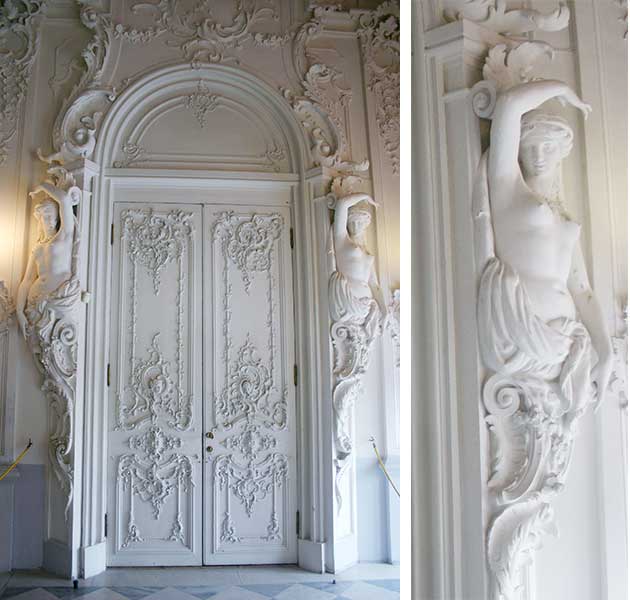
This…is the door into the ballroom. There is, if you can believe it, nothing special about this door. Indeed, compared to most of the doors in this place, it’s downright restrained. There’s no gold on it.
Nearly all the doors are flanked by sculptures of half-naked women, or perhaps more accurately, sculptures of naked half-women. I’m not quite sure what happened to their legs, except perhaps that their breasts were designed to be of such royal magnificence that nobody ever looked down any lower than that, so the artists didn’t bother to finish the bottom bits in a cost-saving move.
Why Elizabeth and both Catherines preferred to be surrounded by naked half-women is a bit of a mystery to your humble scribe, who can only speculate that perhaps Peter the Great’s problems may have been hereditary.
At least these ones don’t squirt at you.
The true horror of the place doesn’t start to become apparent until you venture into the grand ballroom.

Before guests are permitted in, they are required to place little clean-room-style booties over their shoes. Otherwise, apparently, bits of the souls of the dryads get stuck to your shoes, and if you track them outside the containment structure…well, let’s just say it might cause an incident.
Yes, that’s gold up on the walls–a recurring theme past the foyer. I don’t know what that is painted up there on the ceiling. The guide said something about angels and chariots and the hosts of heaven anointing the Tsarina with the divine blessings of imperial monarchy, the better to sell herself to the peasants, or something like that. I’ve always been deeply skeptical by an omniscient, omnipotent divine creator of everything who seems to find it necessary to validate human sociopolitical structures, often to the benefit of the very people who tell you that the omniscient, omnipotent divine creator of everything is validating the current sociopolitical status quo, but I’m just a cynic that way.
The gold-all-over-the-walls motif continues as a theme throughout the palace, even in the state dining hall. Which, in case you were wondering, looks like this.
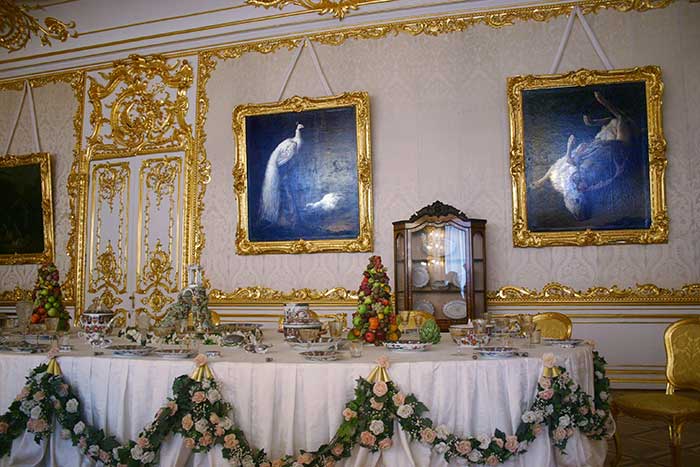
Now, I can’t speak for the fashion of the time, but…eating in the presence of royalty who found it necessary to decorate the dining hall with paintings of dead animals would quite likely put me right off my lunch. PETA could build an entire Web site around this place, to go along with their Web sites suggesting that all household pets should be replaced by robots and campaigning to rename fish “sea kittens”.
It’s hard to get a sense of the real horror of the paintings–again, flash photography was forbidden, so I had to make do with what I could get–but the one on the right is a dead deer, and the one to the left of that shows a dead duck with its neck broken flopped over on the ground next to something–an albino peacock? I’m not sure–that seems quite indifferent to its presence.
These paintings line every wall, so the only place one can look without losing the will to eat (or indeed, the will to live) is either up or down.
Of the two, I suggest down. If you look up, you see this.
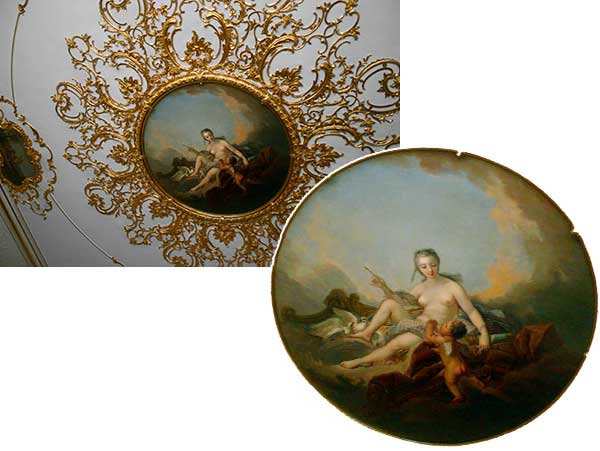
It seems Elizabeth and the Catherines really, really liked their ceiling art. Of half-naked whole women, wholly naked half-women, and/or any combination thereof. This particular piece is called “Cherub, go to your cloud.” Or that’s what I call it, anyway. It’s noteworthy as being one of the finest existing examples of a particular artistic style called Baroque Cthulhu; that frame, during certain times of the year near the winter solstice, can crawl along that ceiling into a dark corner and do awful things. Unspeakable things. Things to drive a strong man mad, and a strong woman long for dark sapphic pleasures.
Elsewhere in the palace, the ceiling art generally returned to the winged-beings-and-chariots leitmotif so often favored amongst royalty and despotic monarchs of all stripes.
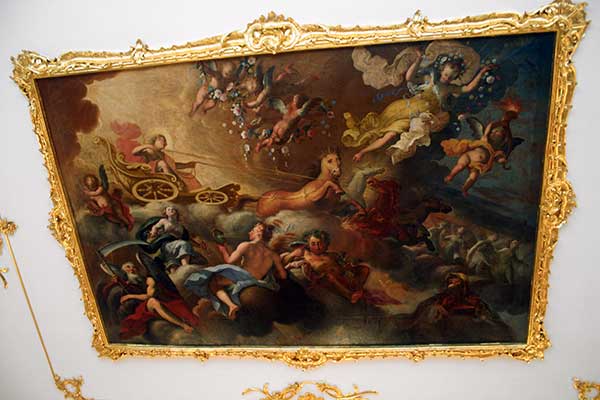
I think this one is called “God Says I Can Do Whatever I Want and M. C. Escher Agrees, So There.” Apparently, violating certain normal conventions regarding perspective is covered by the “whatever I want” part.

A random niche in the side of a wall on a cupola or bell tower or something in back of the palace. Why, yes, they really are that magnificent, and thank you very much. Plus, as you can see, I have legs. Which puts me a leg up on those tarts inside by the doors. Get it? A leg up? Ah, I slay me.
Adventures in Europe, Chapter 12: Urban Life
Whenever I’m in a new city for the first time, one of the things I really like to do is walk the streets. I find that I can get a much better feel for a city when I can…err, you know, feel it.
So when our tour guide of the name that can’t be heard offered us a choice of yet another cultural center or an opportunity to walk around downtown St. Petersburg for a while, I voted for the latter. Since I seemed to be the only one with a strong opinion on the matter, I think I won by default.
St. Petersburg is a strange city. It’s kind of like what might happen if you took Detroit and gave it a real history. It’s a strange mix of palaces, soaring cathedrals, urban shopping malls, and squalor. The result is a weird and jumbled juxtaposition of things, almost as if some space alien had taken a number of architectural works from all over the world and set them down in the middle of Newark in an attempt to create a terrarium for its pet humans.
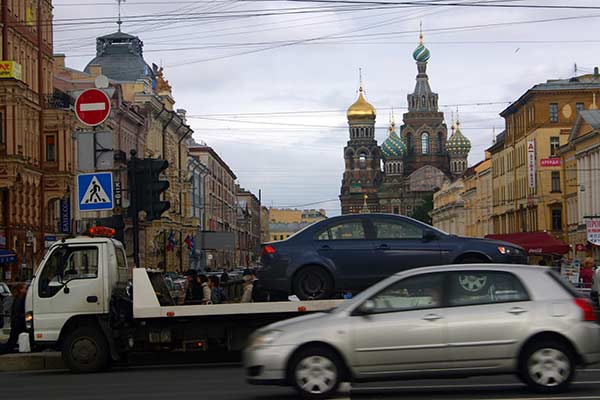
“See? It’s just like their native habitat! They have little roads to drive on, and little signs to read, and even a little church where they can pray to their gods or saints or whatever they call them!”
And statues. Lots and lots and lots of statues. You don’t often see a whole lot of statues in American cities, but St. Petersburg loves its statues, oh yes it does. Statues everywhere. Statues in the roadway. Statues on the bridges. Statues in little niches in the buildings, even.
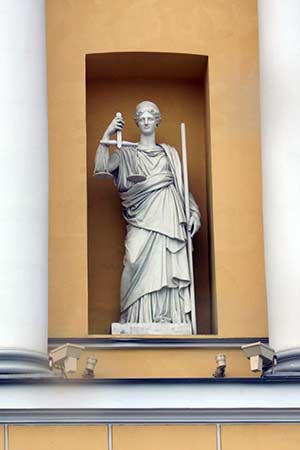
In Soviet Russia, justice is not blind. Justice sees you quite well, Comrade. Justice knows exactly what you did last summer, and has even seen the videotape on YouTube. Justice does NOT approve. Justice thinks you should be ashamed of yourself. The gulag for you, Comrade! As for your family, Justice knows what to do with them, too.
Have a nice day, Comrade.
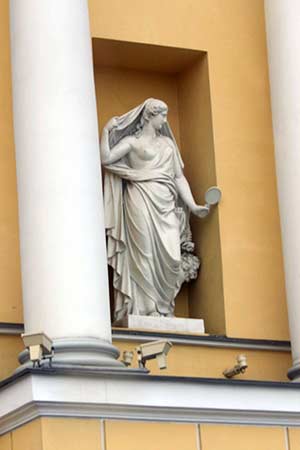
Why yes, they are that magnificent, and thank you very much. (At least these ones look reasonably natural, as if carved by a sculptor who has actually known the touch of a woman.)

This statue, according to our diminutive guide of the statistically improbable name, is the world’s largest bronze casting that’s only supported at two points.
Every town in the world can claim to have something that’s unique. Darwin, Minnesota has the world’s largest ball of string. St. Petersburg has the world’s largest bronze statue that’s only supported at two points. Juarez, Mexico is the murder capital of the world. Tampa, Florida is the lightning capital of the world. Newark, New Jersey is home to a record-breaking number of smells, whereas Seattle, Washington holds the title for the most shades of gray in any one sky. Coeur d’Alene, Idaho has more violent white supremacists per capita than any other city. And Portland, Oregon is home to more cute bisexual Subway sandwich makers with tattoos and facial piercings than any other city.
Some of these claims are, I think, more significant than others. For example, I prefer Portland, Oregon to Juarez, Mexico, on the grounds that (a) I have a fondness for cute bisexual women with tattoos and facial piercings and (b) I can’t indulge my fondness if I’m dead.
It is a cool statue, though. I’m not sure what the thing on top of his hat is.
St. Petersburg is also home to an enormous statue of Vladimir Lenin, erected before everyone discovered what a douchenozzle he was and then never taken down.
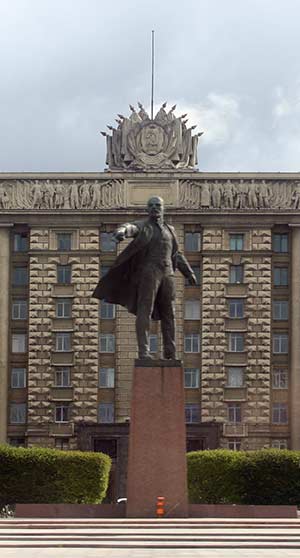
According to our tour guide, this particular pose was quite popular in images of the Great Douchenozzle. He’s supposed to be delivering a stirring lecture to the working class or inspiring the underprivileged or ordering someone to be executed or seizing control of an independent newspaper or something. Apparently, most folks think it looks like he’s hailing a cab.
Lenin wants you to be inspired. Not being inspired is treason. Treason is punishable by death. Are you inspired, Comrade?
The fall of the Soviet Union opened the doorway to Western-style street advertising in the Eastern bloc. It’s really only a matter of time until ClearChannel moves in, and then it’s curtains for the free world.
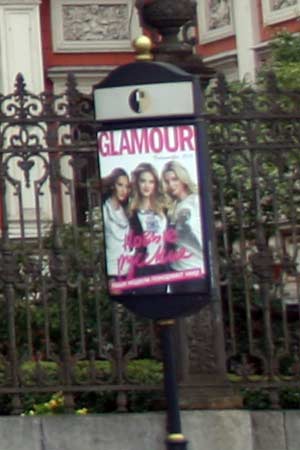
If Lenin were alive today, he’d be spinning in his grave.

Spinal Tap may be big in Japan, but A-Ha is huge in Eastern Europe. Huge, I say! And now I have that one song stuck in my head. You will too. Such is the malignancy of my evil.

I saw this spray-painted in a bunch of places all around St. Petersburg. It’s interesting to see graffiti in a language I don’t recognize. I kept wondering what it was asking.
For all I know, it says “Do you want new car? Check out Vladimir’s House of Cars!” I know there are at least three folks on my flist who can read it…
St. Petersburg was intermittently wet and rainy while we were there. I actually quite like the way a city looks after a rain. I think it’s a consequence of being a child of the 80s and watching all those episodes of Miami Vice where they would wet down the roads before they started filming, just because they liked the texture.
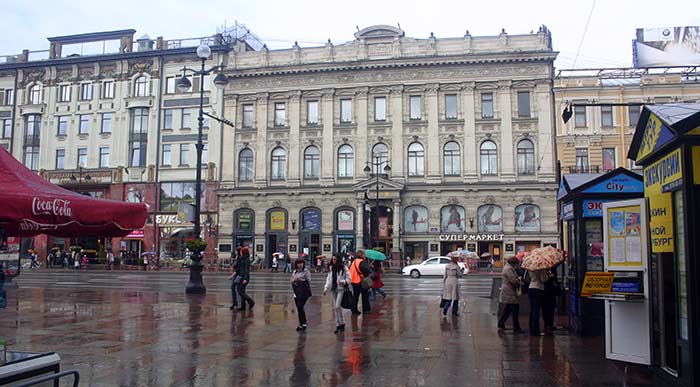
I particularly like the Coca-Cola logo in the foreground. Lenin wept.
We stopped for a while in front of this rather stern-looking building, which apparently was a government office under Peter the Great, then was converted to a government office after the Communists came to power, and now in the post-Soviet era has become a government office.
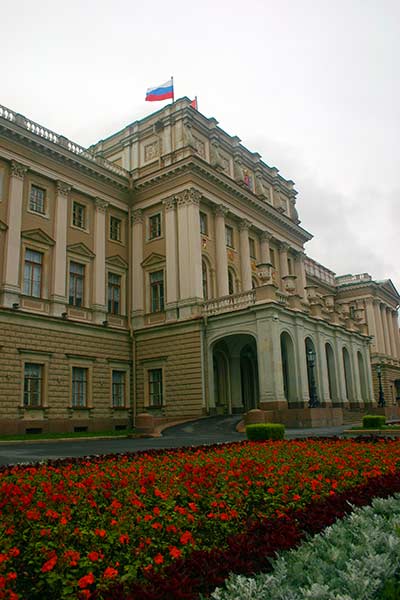
Government offices all over the world seem to share a similar architectural language. This building wouldn’t really look that out of place in Tallahassee or Seattle. (Well, the landscaping is a bit nice for Tallahassee, but you know what I mean.)
One look at the people who were patrolling in front of it, though, and you know you’re not in the United States.
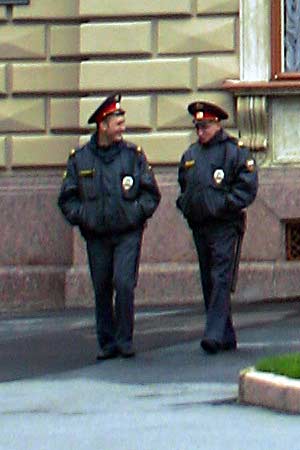
Check out those hats. These guys mean business, and no mistake. Don’t let the jovial expressions fool you–those hats are all business.
Adventures in Europe, Chapter 11: I have so many names…
One of St. Petersburg’s most famous monuments is a sprawling, ornate Russian Orthodox cathedral. Unlike most of the various Orthodox cathedrals throughout Russia, this one isn’t built in the Baroque style, but is built in a style that recalls Medieval Russian architecture.
Medieval Russian architecture is modeled, it seems to me, on the basic design of a turnip. Or perhaps an onion. One of those little white kinds of onions they chop up and put on hot dogs that you get when you’re visiting Boston and you kinda feel hungry but you don’t want to waste the time it takes to go to a restaurant or something, so you stop at a street vendor who’s selling hot dogs out of a little push-cart thingy. There’s an art to finding just the right hot dog street vendor…but I digress.
The cathedral has many names. In Russian, it’s called “Собор Воскресения Христова”. In English, it’s most often referred to as the Church on Spilt Blood, but it also goes by the Cathedral of the Resurrection of Christ, the Church of our Savior on the Blood, the Church of the Resurrection, or the Church of the Assumption.
Personally, I call it the Church of Tsar Alexander II Was a Fucking Idiot.
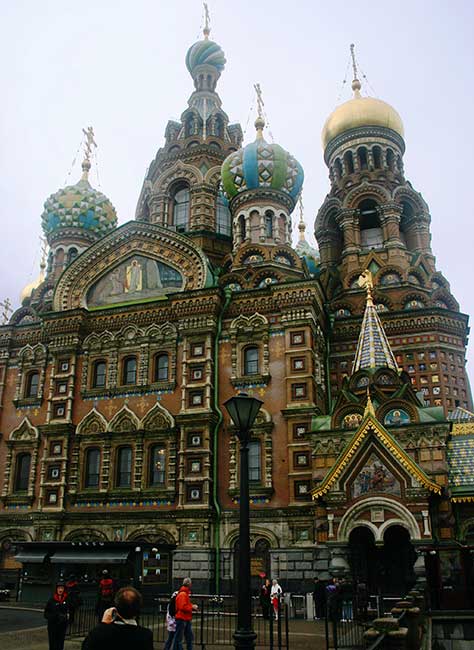
It was built, explained our tour guide of the Name Whose Utterance Invokes The Walking Nightmares, as a monument to Alexander II, who was assassinated on that spot in the late 1800s.
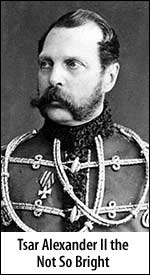 Apparently, he’d been riding along the road, just minding his own business and doing whatever it is a despotic monarch does, when some Anarchist threw a hand grenade at him. The grenade totally missed, and did little more than make some noise and frighten the horses. So Alexander, being a despotic monarch who thought he could do whatever the hell he wanted to, stopped the carriage, got out, and started yelling at the Anarchist who had just thrown a grenade at him. Whereupon another Anarchist just happened to wander by, and just happened to have a grenade in his pocket, and it was curtains for the luckless Tsar. Lacy, gently wafting curtains, on windows gilded in gold with a strange half-Greek-god, half-angel, half-tentacle-monster thing embossed over the top, but curtains nonetheless.
Apparently, he’d been riding along the road, just minding his own business and doing whatever it is a despotic monarch does, when some Anarchist threw a hand grenade at him. The grenade totally missed, and did little more than make some noise and frighten the horses. So Alexander, being a despotic monarch who thought he could do whatever the hell he wanted to, stopped the carriage, got out, and started yelling at the Anarchist who had just thrown a grenade at him. Whereupon another Anarchist just happened to wander by, and just happened to have a grenade in his pocket, and it was curtains for the luckless Tsar. Lacy, gently wafting curtains, on windows gilded in gold with a strange half-Greek-god, half-angel, half-tentacle-monster thing embossed over the top, but curtains nonetheless.
Alexander, like many a monarch before him, forgot the lesson so clearly articulated by Ambrose Bierce, which is that an absolute monarch can do as he pleases so long as he pleases the assassins.
His successor to the throne, the unimaginatively named Alexander III, commissioned the church to be built in the exact spot where Alexander II was sent to meet his maker in little teeny bits. Hence, Church of Tsar Alexander II Was a Fucking Idiot. There’s an important lesson in here for you, kids. When someone has just tried to kill you with an explosive device, don’t stand around arguing with him. His friends might have explosive devices, too.
And better aim.
Alexander III wanted a way to memorialize his dear departed dad. Since the first thing he did upon reaching the throne was to try his damndest to erase his father’s legacy, and since one of the ways in which he set about doing that was to fuel a revival of nationalist sentiment by strengthening the Russian Orthodox Church at the expense of other religious traditions, memorializing his rather unwise predecessor by building a church seemed like a gimme.
The place is mind-blowing, in a way that only religious edifices can be. This is what it looks like on the inside:
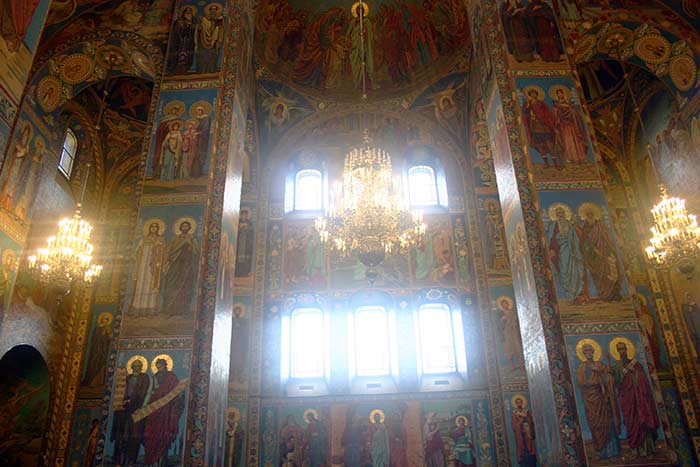
A few months ago, I visited a Mormon temple for the first time. Mormon temples are awe-inspiring structures, and I mean that in the most literal sense possible. Every aspect of the temple’s architecture, from the choice of materials to the shape of the front door, is carefully calculated to create feelings of awe in anyone who sees them. It’s a devastatingly effective technique for emotional manipulation; if you can stir up the right feelings, you can make people forget that the religion was founded by a huckster and convicted fraud artist as a way to con people out of their money.
It works. I could probably write an entire book about creating spaces that manipulate people on an emotional level, just from one afternoon at the temple. The Disney Imagineers have nothing on the Mormons when it comes to manufacturing spaces that inspire an emotional response.
And the Mormons got nothin’ on the Eastern Orthodox architects when it comes to doing the exact same thing. It’s difficult to express in shitty low-resolution JPEGs just how incredibly affecting the architecture of this place is designed to be.
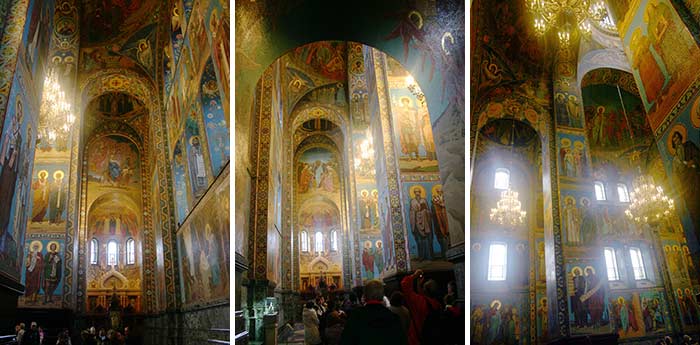
I probably need not say this by now, but yes, that’s real gold up on the walls.
The impact such a building must have had on an illiterate, poorly-educated serf must have been fiercely overwhelming. Take a guy who’s never learned to read, has never seen anything more grandiose than a wood shack or the back end of a horse, a guy whose life is metered out in units of cow manure and bales of hay, and bring him into a place like this, and he’s yours. One look around inside this cathedral and you’d be able to convince him that up is down, black is white, left is right, and there’s an invisible man who lives up in the sky and who wants him to give you money. Or his wife. Or both.
Speaking of invisible men who live up in the sky, the entire building is filled, from one end to the other, of pictures of them. The Roman Catholics don’t got nothing on the Eastern Orthodox when it comes to saints. They gots hundreds of them. They like putting pictures of all of them everywhere they can, floor to ceiling, culminating in this picture up on the central dome just in front of the altar in almost every Orthodox church:
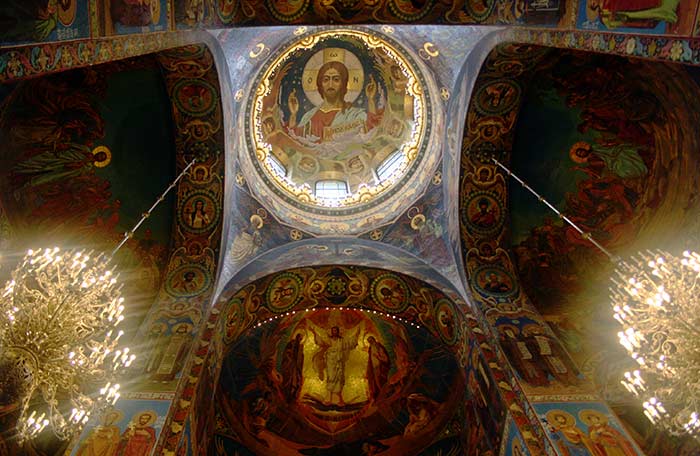
That’s Jesus up there, in his role as Jesus, King of the Universe–a depiction which the actual person, if indeed he existed, would no doubt have found…surprising. It is a truism of Christianity that Jesus became what he set out to destroy.
But I digress.
The Russian Orthodox Church is so fond of its saints that it even puts ’em all over the screen that separates the main part of the church from the sanctuary, where the altar itself and the various widgets and objects used in the magical process of turning cheap wine and bland crackers into the stuff of ritual cannibalism is kept.
These icons dedicated to the hundreds and hundreds of sacred figures in the vast pantheon that is monotheistic Orthodox Christianity are adulated by the faithful, but it should be pointed out that this is not idolatry. The Orthodox understand that when they pray before or genuflect to an image, they are actually paying respect to the thing the image represents, not like those idolaters who build a representation of a sacred force and then pay homage to them as a way to respect the thing that the image represents. Clear?
Add the grandeur of this place to the secret magical rituals carried out by the priest class behind that screen, and our poor illiterate serf never had a chance.
The Church of Tsar Alexander II Was a Fucking Idiot is no longer an actual cathedral. When the Bolsheviks took power, they looted the place. Lenin reportedly wanted to demolish it, according to our tour guide, but was persuaded not to by some of his underlings. For a long time, it was used as a warehouse for potatoes, and it wasn’t until after the fall of the Soviet Union that anyone bothered to restore it.
Back when I was a a very young child, I used to love playing hide and go seek. Somewhat later, in my middle school days in Nebraska, I played a more elaborate version called “ditch ’em,” which pits two teams of players against one another, preferably late at night on a minimum of fifteen acres of ground or so.
A central part of the structure of both games is the concept of a “home base.” People who are on their home base can’t be tagged by the people chasing them; home base is the ultimate sanctuary.
After it was restored, the Church of Tsar Alexander II Was a Fucking Idiot was never reconsecrated. Consecration is, as near as I can gather, a process by which a church or other religious structure is specially designated as a sort of religious home base in the grand theological game of tag; a consecrated structure is safe against demons or the army of the walking dead or something. If it ain’t consecrated, the rules say you can’t use it as a church, or something like that.
Since this place isn’t consecrated any more, on account of the potatoes, it’s now just a museum rather than a church. I’m not sure the distinction really matters much to Alexander II, who I’m sure if he had it to do over again would perhaps prefer to forego the honor of having the church built in his memory in favor of not being blown to bits with a grenade in the first place.
